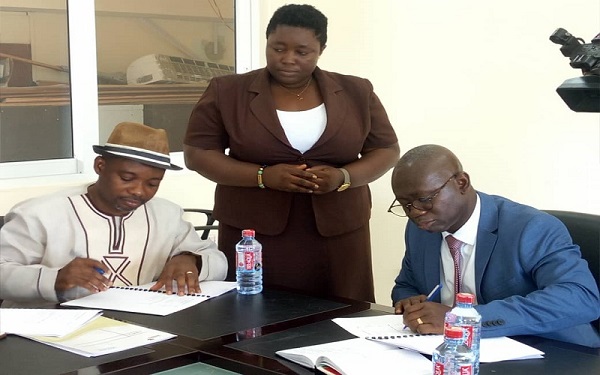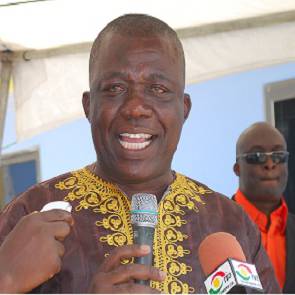
Director General of the GES, Prof. Kwasi Opoku Amankwa and Country Director of MPA; Chief Nat Ebo Nsarko signing MoU
One of the daunting challenges confronting Ghana, especially, managers of its educational system, is the lack of adequately suitable classrooms for all children to sit and learn.
This challenge which is very prevalent at the basic school level, has led to many schools where there are lack of infrastructure, to set up classes under trees to provide teaching and learning for the children.
To address this problem, the Ghana Education Service (GES) has teamed up with Millennium Promise Alliance (MPA), a non-governmental organization with footprints in more than 20 countries, to assist in identifying these schools to enable them know the kind of support to give to each of those schools.
A Memorandum of Understanding (MoU) was on Monday, April 8, 2019, signed between the two parties to that effect.
Per the dictates of the MoU, MPA will assist the GES to map all basic schools in Ghana so that schools under trees as well as those with poor infrastructure will be identified and prioritized.
This will enable the GES to know at the click of a button, location of all these schools and to strategize on how to assist each with a modernized school infrastructure.
MPA will further team up with the GES to scale up its mobile School Report Card (mSRC), having successfully piloted it in 20 districts.
The two institutions are also to collaborate to develop Mobile Handheld and ICT Policy framework for the mSRC which was introduced by the GES with support from UNICEF in 2016 to check teacher absenteeism at the basic level.
The duo will moreover, build on the capacity of GES staff, especially, the ICT team at the district, regional and national levels, on the back-end of the mSRC system.
The Country Director of MPA, Chief Nat Ebo Nsarko, commenting on the initiative prior to the signing of the MoU on behalf of his outfit said he is confident the mapping of all basic schools under trees will help address the controversies surrounding those schools and further assist the government to plan and mobilize enough resources to build school infrastructure in areas where they are lacking.
“…you know we’ve heard a lot of schools under trees. Sometimes you will travel and you would want to see those schools under trees and you may not see them. So, we want to do what we call mapping of the schools so that at the click of a button, you will know where all these basic schools are – if indeed they are under trees, the GPS location will just expose that. I am sure that you will be interested to know how many schools are under trees so that you can address that situation. The records and the data will be there to support you to identify these schools under trees so that we can help”, he noted.
He added “MPA’s support for Ghana’s ICT Policy for Education is intended to coordinate the appropriate development, efficient delivery, and quality use of technology to ensure ICT integration for excellence and equity in education. MPA recognizes the centrality of education to sustainable development, and as many of us are aware, education is a goal in its own right in the SDGs. This initiative is well aligned with Government’s education sector priorities as outlined in the Coordinated Programme of Economic and Social Development Policies 2017-2024”.
The Director General of the GES, Prof. Kwasi Opoku Amankwa, who initialed for his side, on his part expressed the belief that the collaboration will further propel the GES to attain greater heights in its fight against teacher absenteeism while improving teaching and learning at the basic school level.
About the mSRC
The mSRC was developed in 2016 by the GES in collaboration with UNICEF and other key partners to collect essential data on school attendance for both teachers and students and visualizes the analyzed data through dashboards.
The system enables the GES to keep track of teaching and learning at the basic school level.
For instance, the system keeps track of whether teachers and students were attending school and what activities were they engaged in during teaching hours.
The system was piloted in 20 districts where tablets with in-built applications were provided to circuit supervisors for monitoring and evaluation purposes.
The system is networked such that from the district to the region through national, the data for a particular school is accessible.
What do you think about this piece? Share your comment in the comment thread and share the story using the social media buttons above. You may reach the editor on 0249579664. Thank you.





